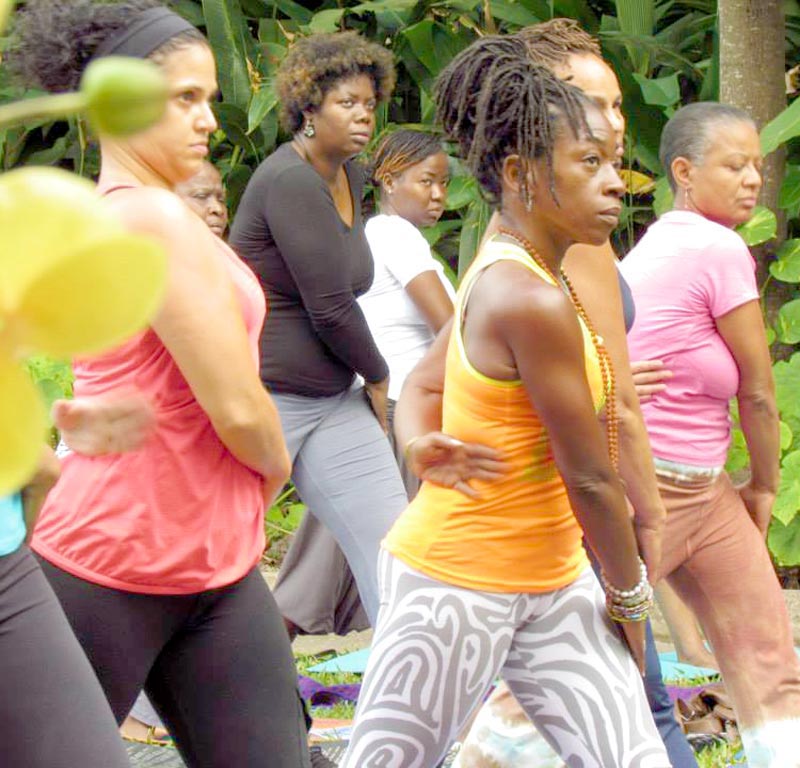The practice of yoga continues to grow exponentially world-wide. Yoga is one of the physical, mental, and spiritual practices or disciplines, which originated in ancient India. It aids in attaining a state of permanent peace of mind. Extensive research reveals this practice dates back over 10,000 years in Egypt. According to Yirser Ra Hotep, a recognized Kemetic yoga teacher, Kemetic Yoga is an ancient Egyptian system of Yoga enlightenment based on the practices of physical movements combined with controlled deep breath-work.
The practice of yoga integrates all three aspects of being human: the physical, the mental and the spiritual or soul level. An English translation of the word yoga (which is Sanskrit, an ancient Indian language) is to yoke or unite.
Though various schools or types of yoga exist, the basic tenets of yoga – proper breathing, proper exercise, proper diet, positive thought, prayer and meditation and proper relaxation and rest – resonate throughout them all. When these facets are in alignment it gives rise to a more balanced, harmonious and organic way of being.
As medical studies increasingly reveal, the number one root cause of ‘disease’ or illness is stress. Left to its own devices it wreaks havoc on our entire being. It is perhaps this fact that has given rise to the 21st Century yoga boom in the West.
An article in Yoga Journal’s September 2013 issue entitled ‘Good for You! 21 ways that your yoga practice can improve your health’ states the following:
“Researchers are uncovering fascinating evidence of how the practice affects us mentally and physically and may help to prevent and assist in the treatment of a number of the most common ailments that jeopardize our vitality and shorten our lives. Some examples include anxiety, back pain, depression and heart disease. There have been subtle yet profound shifts in the well being of persons who have chosen to embrace yoga as a part of their lifestyle. Nowhere is this more evident than when yoga is used as a healing tool for dealing with trauma resulting from emotional, physical and psychological abuse.
A natural coping mechanism for dealing with trauma is to dis-associate from it. The adverse effect of this is trauma being trapped within the body at a physiological level, manifesting sooner or later as illness.
In the words of Carolyn Myss, a noted author and world-renowned speaker, ‘your biography becomes your biology.”

In Kingston’s maximum-security prison, the General Penitentiary , inmates practising yoga have reported increased quality in their sleep patterns and even more importantly, relate that it is an effective tool for anger management. In fact, authorities at GP assert that inmate-fighting rates dropped to virtually zero for those who practice yoga.
For many, their segway into yoga began with the physical or asana practise carried
out on a yoga mat. Hatha yoga, which forms the basis for all types of yoga, is essentially comprised of 12 basic asanas. A typical yoga practice first involves breath-work or pranayama, then movement through the asanas and concludes with relaxation found through savasana otherwise known as corpse pose – this is where you lie completely still on your back at the end of a practice. Savasana serves as the moment when the students invite their body to absorb the benefits of practicing asana.
Yoga is best practised in the morning and on an almost empty stomach, when the body is naturally in elimination mode. While the promise of a more flexible, toned body has brought practitioners in the droves to the mat, yoga works from the inside out. When our internal organs are functioning optimally, we feel and look better. Certain poses such as twists help to detoxify the body and strengthen the spine.
Another example of the internal benefits of the practice includes forward bending which aids in digestion; it also provides relaxation for proper rest.
Perhaps the greatest fallacy about yoga is that one needs to have a flexible body in order to practise. An open mind is what creates the possibility for flexibility within the body. A balanced yoga practice is one that harnesses both strength and flexibility.
In spite of all of these wonderful reports about the benefits yoga provides, it is not for everyone. In the film The Titans of Yoga, co-founder of US-based Jivamukti Yoga, David Life states: “If your life is already working beautifully for you, then there’s no need for yoga”.
No matter your size, shape, religious affinity, colour, class or creed, there is a form of yoga for you.
With a plethora of information about yoga available ‘out there,’ where do you start?
- Consult your physician before engaging in any physical activity, especially if you have any pre-existing conditions
- Begin slowly: Try out different types of yoga and see what most attracts you
- Practise at least 3 times weekly to start; then without judgment, analysis or interpretation, simply notice how you feel.
- Inquire into yourself and your practice; i.e., research and reflect upon your findings
- Don’t take the practice nor yourself too seriously
- Most importantly, have FUN!
- The Jamaica Yoga Association (JAYA) offers community classes open to all levels.

